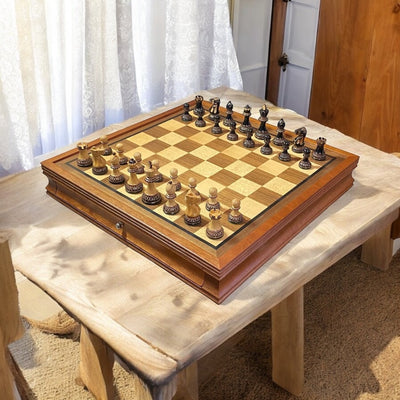Chess Pieces Design and History
Before the introduction of the Staunton design, the pieces most generally used were called the St. George design chessmen, followed by the Calvert, Edinburgh, Lund and Merrifield designs. Most of the sets of the interval were comparatively expensive to make and fairly intricate.
It is strongly recommended that Jaques truly designed a relative, plus the Staunton pieces, Nathaniel Cook filed the wooden chess pattern under the Ornamental Designs Act of 1842. The symbols were used by them in their most basic form, and a heavy foundation that was broad made them less likely to tip. In September 1849 the production rights were bought by John Jaques of London, workers of fine and ivory woods. Jaques was the brother in law of Nathaniel Cook. Jaques removed a lot of the decorative features that managed to produce the brand new design at less price, and topped chess patterns that were earlier. On September 8, 1849 the first wooden chess sets from Jaques became accessible. The very first sets had red crowns in addition to King's Knight and the King's Rook that differentiated them from the Queen's Rook as well as the Queen's Knight. They were frequently marked with "J. Jaques London" on the foundation of the King as well.
On the same day that the Jaques chess sets were accessible, Howard Staunton supported the sets and advocated. The ad that appeared in the paper called it Mr. Staunton's pattern. After, Staunton began supporting the set and had his signature on the carton of Staunton chess pieces. One of Staunton's chess novels was given free with every Staunton chess set. Marketting and star endorsement helped, but the simplicity of the Staunton layout probably contributed the most to its success. Nevertheless the Jaques Staunton's were not the instant success that Howard would have had us believe. The Staunton pattern was just adopted by FIDE in 1934 and there were other challengers for the title.
It is strongly recommended that Jaques truly designed a relative, plus the Staunton pieces, Nathaniel Cook filed the wooden chess pattern under the Ornamental Designs Act of 1842. The symbols were used by them in their most basic form, and a heavy foundation that was broad made them less likely to tip. In September 1849 the production rights were bought by John Jaques of London, workers of fine and ivory woods. Jaques was the brother in law of Nathaniel Cook. Jaques removed a lot of the decorative features that managed to produce the brand new design at less price, and topped chess patterns that were earlier. On September 8, 1849 the first wooden chess sets from Jaques became accessible. The very first sets had red crowns in addition to King's Knight and the King's Rook that differentiated them from the Queen's Rook as well as the Queen's Knight. They were frequently marked with "J. Jaques London" on the foundation of the King as well.
On the same day that the Jaques chess sets were accessible, Howard Staunton supported the sets and advocated. The ad that appeared in the paper called it Mr. Staunton's pattern. After, Staunton began supporting the set and had his signature on the carton of Staunton chess pieces. One of Staunton's chess novels was given free with every Staunton chess set. Marketting and star endorsement helped, but the simplicity of the Staunton layout probably contributed the most to its success. Nevertheless the Jaques Staunton's were not the instant success that Howard would have had us believe. The Staunton pattern was just adopted by FIDE in 1934 and there were other challengers for the title.






